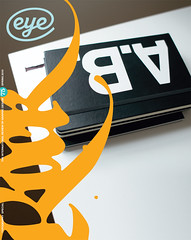Spring 2010
Sensational now
Digital Pioneers
Victoria and Albert Museum, London<br>December 2009–25 April 2010Depending on your expectations, ‘Decode’ at the V&A could leave you feeling full of wonder or a little disappointed. It is essentially a progress report from a group of passionate artisans experimenting with new tools to push the boundaries of what is possible with their chosen material. Given the experimental and open nature of the work, you may at times wonder whether this series of installations should be judged as you would a contemporary art show. But, as the subtitle clearly states, this is a design show about sensation and this is how it is best understood.
‘Decode’ is presented in three sections – ‘Code’, ‘Network’ and ‘Interactivity’. As you might expect, the first features work generated entirely through programming. The designers who manipulate this code represent an exciting group of artisans whose craft is centred on a set of virtual tools and virtual material. Much of this code is ‘open source’ and is a collage of algorithms and instructions pieced together from ideas shared across the internet. The results are mostly decorative abstract animations presented at a modest scale, often on a small screen. Many are quite beautiful, sumptuous compositions but if you look for a conceptual core their inspirations might seem somewhat underdeveloped. The craft itself is impressive, however, and it is difficult not to be impressed that all of this can be so skilfully visualised through abstract technical instructions.
In ‘Network’ the authors place the work in a larger social arena and extend the possibility of collaboration to an infinite number of contributors. This includes interacting from remote locations using the Web or placing sensors in very public places and translating the data into visual maps. For example, Aaron Koblin’s Flight Patterns tracks US air traffic, animating a complex set of data from a single day in real time into an eerie continuous flow of ghostly traces to create a pulsing map. It is a part of the show where you sense a more satisfying combination of craft and content.
The work in ‘Interactivity’ uses sensors of all kinds to respond in a physical way to the presence of the viewer, exploring the use of sensors. Mehmet Akten employs motion sensors to enable a digital version of action painting in Body Paint and on a smaller scale, Robert Hodgin uses a microphone as an input device for a re-staging of his haunting ‘Solar’.
Initially, this feels very like a contemporary art space, with projected works that take your entire field of vision and are presented in distinct separated bays, but it is also likely to be full of people waving arms around to interact with the installations. This can make an enjoyable contrast to other V&A galleries, though you may crave more sophistication in the interaction. Despite this I was impressed by the way that the elaborate electronic and mechanical engineering in Daniel Rozin’s Weave Mirror recreates an image of the viewer on 768 rotating discs, each displaying a small c-type print of continuous tone.
I would encourage anyone visiting ‘Decode’ to spend time upstairs in the prints and drawings gallery, where the early computer-generated artwork in ‘Digital Pioneers’ provides a useful historical context, and a more rounded sense of the dialogue around digital work and its development over the past 40 years.
Both shows demonstrate a fascination with algorithms and the desire to adapt tools intended for a different use. You can see that the move towards team-based production had already shown itself by 1970, and sense a recent tendency to take inspiration from nature – to help relate digital work more closely to ‘real’ human experience. Simon Heijdens’ Tree (2009), for example, links the graphic in the gallery directly to the weather outside; digital leaves drift across the floor as you walk through the space.
What is markedly different about ‘Decode’ is a sense of the audience and the live aspect to the interaction. Its focus on sensation marks it out as a show of its time. It mirrors the experience of action movies or digital gaming, where the experience is as important as the underlying narrative – the thrill of the journey is as important as the destination. Viewed alongside ‘Pioneers’ you realise there is a need to encourage this type of play and it is brave of the V&A to play host to this. We need a digital playground for its long-term impact.
Both these shows feature ideas that have led to applications in more accessible formats. Fabrica’s Exquisite Clock, for example, is already available as an iPhone app, and other exhibitors such as Karsten Schmidt, Matt Pyke, John Maeda and Sascha Pohflepp are using these experiments to inform commissions for mainstream clients. The true value of ‘Decode’ may only be clear 40 years from now, when we can look back at this work and see the role it played in determining our subsequent relationship with digital media.
First published in Eye no. 75 vol. 19 2010
Eye is the world’s most beautiful and collectable graphic design journal, published quarterly for professional designers, students and anyone interested in critical, informed writing about graphic design and visual culture. It is available from all good design bookshops and online at the Eye shop, where you can buy subscriptions and single issues.

